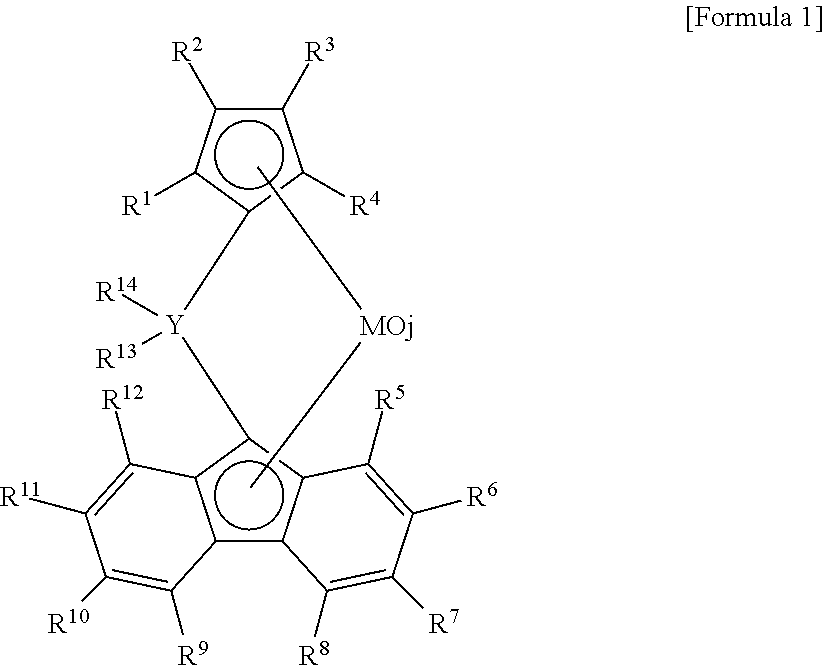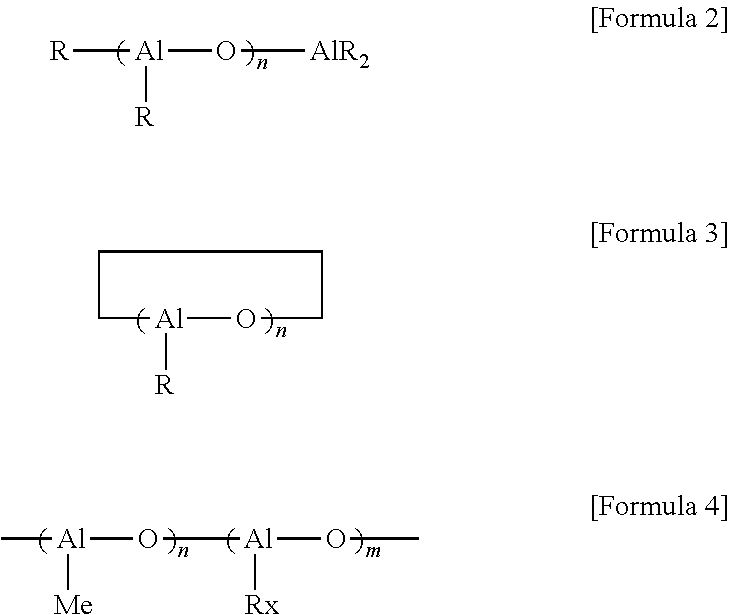Copolymer of ethylene and alpha-olefin, and method for preparing same
a technology of alpha-olefin and copolymer, which is applied in the field of copolymer of ethylene and alpha-olefin and method for preparing the same, can solve the problems of high cost, difficult to obtain high, and high cost of linear alpha-olefin raw materials, and achieve excellent heat and oxidation stability, excellent uniformity, and high viscosity index.
- Summary
- Abstract
- Description
- Claims
- Application Information
AI Technical Summary
Benefits of technology
Problems solved by technology
Method used
Image
Examples
example 1
Preparation of the Ethylene and Alpha-Olefin Copolymer
[0051]A. Preparation of catalyst solution: To a glass flask filled with nitrogen gas, 0.15 mmol of diphenylmethylene{η5-(3-n-butylcyclopentadienyl)}{η5-(2,7-di-tert-butylfluorenyl)}zirconium dichloride, 0.2 mmol of dimethlylanilium (tetrakis pentafluorophenyl) borate 0.2 mmol, 8 mmol of triisobutyl aluminum and toluene were introduced and mixed, to prepare the catalyst solution of 120 ml.
[0052]B. Polymerization: 375 ml of hexane was injected to stainless autoclave (area: 1.1 L) filled with nitrogen gas, a temperature of reaction system was heated to 70° C., and then 15 ml of catalyst solution prepared at Step A was added. Next, 260 g / hr of ethylene, 12.40 ml / min of liquid propylene, 1.95 g / hr of hydrogen, 30 ml / min of hexane, and 0.25 ml / min of catalyst solution were continuously injected, and initiated the copolymerization reaction with stirring at 1630 rpm. Thereafter, the catalyst injection amount was reduced, finally 0.07 ml / ...
example 2
Preparation of the Ethylene and Alpha-Olefin Copolymer
[0054]The procedures were performed in the same manner as described in Example 1, excepting that supply rate of hydrogen was changed to 0.65 g / hr, to obtain 460 g of the ethylene and alpha-olefin copolymer. The polymerization condition for the copolymer was shown in Table 1, the physical features of obtained copolymer were analyzed, and the result thereof were listed in Table 3 and 4.
example 3
Preparation of the Ethylene and Alpha-Olefin Copolymer
[0055]The procedures were performed in the same manner as described in Example 1, excepting that supply rate of hydrogen gas was changed to 0.35 g / hr, to obtain 470 g of the ethylene and alpha-olefin copolymer. The polymerization condition for the copolymer was shown in Table 1, the physical features of obtained copolymer were analyzed, and the result thereof were listed in Table 3 and 4.
PUM
| Property | Measurement | Unit |
|---|---|---|
| Temperature | aaaaa | aaaaa |
| Temperature | aaaaa | aaaaa |
| Viscosity | aaaaa | aaaaa |
Abstract
Description
Claims
Application Information
 Login to View More
Login to View More - R&D
- Intellectual Property
- Life Sciences
- Materials
- Tech Scout
- Unparalleled Data Quality
- Higher Quality Content
- 60% Fewer Hallucinations
Browse by: Latest US Patents, China's latest patents, Technical Efficacy Thesaurus, Application Domain, Technology Topic, Popular Technical Reports.
© 2025 PatSnap. All rights reserved.Legal|Privacy policy|Modern Slavery Act Transparency Statement|Sitemap|About US| Contact US: help@patsnap.com



